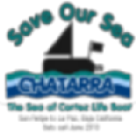|
Chatarra – Helping to save the Sea of Cortez on a plastic bottle Life Raft (Posted 4/15/13)
The Baja Good Life Club (BGL Club), a Baja retirement and travel club, want to raise awareness about plastic waste in the Gulf of California, more commonly known as the Sea of Cortez. The club is inspired to build Chatarra, a 20-foot raft made from reclaimed plastic bottles and other recycled materials to sail from San Felipe, Baja California to La Paz, Baja California Sur in mid-June. The Chatarra idea was originally thought of by John and Rachel Pack, nearly three years ago during the 'The Baja Love Ride' , a fundraising cycling challenge from Rosarito to San Felipe to raise funds for less fortunate Baja Children. Then this past summer, it was again discussed in length during the Baja Walk, a 850-mile walk from San Felipe to Cabo San Lucas to raise awareness for Baja children and animals. Led by John and Rachel Pack, founders of the BGL Club, adventurers, and environmentalists, the Chatarra is set to sail from San Felipe to La Paz. Chatarra's mission is to draw attention to the large amounts of plastic debris in the Sea of Cortez and to help inform communities on the coast how to reduce plastic waste, and how recycled materials can be a resource for the future. John and Rachel Pack, and their BGL Club team members will navigate more than 600 nautical miles from the Bay of San Felipe to the beautiful Bay of La Paz, where the boat will be dismantled and recycled. According to the Center for Biological Diversity, plastic pollution harms an estimated 100,000 sea turtles and marine mammals and 1,000,000 sea creatures each year. As plastic debris floats in the seawater, it absorbs dangerous pollutants like PCBs, DDT and PAH. These chemicals are highly toxic and have a wide range of chronic effects, including endocrine disruption and cancer-causing mutations. The concentration of PCBs in plastics floating in the ocean has been documented as 100,000 to 1 million times that of surrounding waters. When animals eat these plastic pieces, the toxins are absorbed into their body and passed up the food chain and ultimately to our dinner plates. For more information, visit www.bglclub.com, under "Challenges"
|
